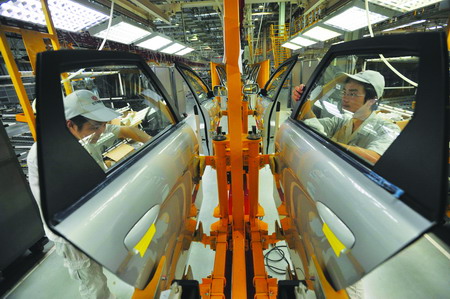Investment
Investors flocking to central area
By Ding Qingfen and Zhou Siyu (China Daily)
Updated: 2010-10-27 08:12
 |
Large Medium Small |
|
 Workers at a Dongfeng Motor Corp plant in Wuhan, capital of Hubei province. Zhou Chao / for China Daily |
Labor costs, infrastructure and market attracting firms to region
BEIJING - Cheap and qualified workers as well as a growing consumer market and maturing infrastructure are helping to turn China's central region into a popular destination for foreign and domestic investment, many companies have said.
Earlier this month, Pfizer, the world's largest pharmaceutical company, announced that it will set up a research and development (R&D) center in Wuhan, capital of Hubei province.
Pfizer did not disclose its exact investment, but the Wuhan center is considered to be the second of its kind that the company has set up in China after its Shanghai R&D center, which largely focuses on biopharmaceutical R&D and innovation initiatives to support global scientific studies.
The Wuhan center is also said to be the first such facility in China's central region set up by an international pharmaceutical firm.
"It will be a significant part of our global R&D operations, helping the nation to strengthen the biopharmaceutical industry in the region," said Mikael Dolsten, president of Pfizer Worldwide Research and Development.
Due to its lower labor costs, China's central region is drawing international enterprises like Pfizer that have been cutting costs to tide over the financial crisis, analysts said.
Hubei is one of the six provinces that make up the central hinterland. The other five provinces are Shanxi, Anhui, Jiangxi, Henan and Hunan.
The central region holds about a quarter of the nation's population, or 370 million people.
During the first eight months of the year, the funds flowing into China's central region grew by 19.5 percent from a year earlier to $4.23 billion, accounting for 6.41 percent of China's total foreign direct investment (FDI) during the same period, according to figures from the Ministry of Commerce. The growth rate is two percentage points higher than that of the country's eastern area.
In April, the State Council also released a new foreign investment directive which pointed out that the nation's central and western regions will be given preferential policies in finance, taxation and land use as part of a strategy to adjust the nation's investment structure.
Other than costs, international enterprises consider access to a large talent pool as integral to investment.
"The most important challenge for setting up R&D centers in emerging markets like China is finding and developing the talent as quickly as we're growing," said Jeffrey B. Kindler, chairman and chief executive officer of Pfizer.
But "we are very enthusiastic about the quality of people in China that are available to work for Pfizer. One of the reasons that we are in Wuhan is that there are great scientific centers here, with a million university students in the city", he said.
By the end of 2012, Pfizer Wuhan R&D center will recruit more than 200 employees, he said.
Pfizer is not alone. US-based healthcare company Herbalife, which ventured into China in 2005, recently announced that it will establish an extraction facility with an investment of $25 million in Changsha, capital of Hunan province.
"Changsha has rich raw material resources for making healthcare products, but a more important reason is that the city has a geographically strategic position and provides an efficient and strong platform for supply and consumption," said Richard P. Goudis, chief operating officer of Herbalife.
During the second quarter of this year, Herbalife's sales in the Chinese market witnessed year-on-year growth of up to 25 percent and the country is one of the company's top 10 markets.
Goudis said the company is confident that "in the next five to 10 years, China will be No 1, and the Changsha plant is a very important factor" in reaching that goal.
Analysts agreed that the central region enjoys many advantages, including rich resources, maturing coordinated industries and a huge pool of talent. These are all factors that are making the area a fairly attractive destination for FDI.
The provinces in the central region are now reaping the rewards from the inflow.
FDI in Jiangxi from January to August alone grew 19.83 percent to $3.28 billion, 8.96 percentage points higher than last year, making the province the top one in the central region in terms of investment volume. In 2009, FDI created about 35 percent of the province's GDP.
"The foreign investment brings significant benefits to our economic growth," said Wu Xinxiong, governor of Jiangxi province.
More companies are considering transferring their factories to the central region to reduce labor costs amid a new wave of wage increases in China's coastal cities.
In August, Foxconn Technology Group, the world's largest contract electronics maker, announced an investment of $20 million in Fengcheng, Jiangxi.
Taiwan-based Teco Electric and Machinery Co, a leading electronic machinery producer, is also gradually transferring its production base for heavy electric machinery in the United States to Nanchang, capital of Jiangxi. "We have already invested a total of $30 million in this factory. In the next few years, it will become our largest production base worldwide," said Xiao Ming, vice-president of Teco.
"The labor and raw materials are cheaper On top of that, we have good offers here, including preferential policies for land use," he said.
China Daily